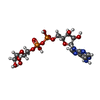[English] 日本語
 Yorodumi
Yorodumi- PDB-8j4u: Structure of HerA-Sir2 complex from Escherichia coli Nezha system -
+ Open data
Open data
- Basic information
Basic information
| Entry | Database: PDB / ID: 8j4u | ||||||
|---|---|---|---|---|---|---|---|
| Title | Structure of HerA-Sir2 complex from Escherichia coli Nezha system | ||||||
 Components Components |
| ||||||
 Keywords Keywords |  IMMUNE SYSTEM / defense system HerA Sir2 IMMUNE SYSTEM / defense system HerA Sir2 | ||||||
| Function / homology |  Function and homology information Function and homology information | ||||||
| Biological species |   Escherichia coli (E. coli) Escherichia coli (E. coli) | ||||||
| Method |  ELECTRON MICROSCOPY / ELECTRON MICROSCOPY /  single particle reconstruction / single particle reconstruction /  cryo EM / Resolution: 2.97 Å cryo EM / Resolution: 2.97 Å | ||||||
 Authors Authors | Chen, Q. / Yu, Y. | ||||||
| Funding support |  China, 1items China, 1items
| ||||||
 Citation Citation |  Journal: Mol Cell / Year: 2023 Journal: Mol Cell / Year: 2023Title: Multiple enzymatic activities of a Sir2-HerA system cooperate for anti-phage defense. Authors: Dongmei Tang / Yijun Chen / Hao Chen / Tingting Jia / Qiang Chen / Yamei Yu /  Abstract: In response to the persistent exposure to phage infection, bacteria have evolved diverse antiviral defense mechanisms. In this study, we report a bacterial two-component defense system consisting of ...In response to the persistent exposure to phage infection, bacteria have evolved diverse antiviral defense mechanisms. In this study, we report a bacterial two-component defense system consisting of a Sir2 NADase and a HerA helicase. Cryo-electron microscopy reveals that Sir2 and HerA assemble into a ∼1 MDa supramolecular octadecamer. Unexpectedly, this complex exhibits various enzymatic activities, including ATPase, NADase, helicase, and nuclease, which work together in a sophisticated manner to fulfill the antiphage function. Therefore, we name this defense system "Nezha" after a divine warrior in Chinese mythology who employs multiple weapons to defeat enemies. Our findings demonstrate that Nezha could sense phage infections, self-activate to arrest cell growth, eliminate phage genomes, and subsequently deactivate to allow for cell recovery. Collectively, Nezha represents a paradigm of sophisticated and multifaceted strategies bacteria use to defend against viral infections. | ||||||
| History |
|
- Structure visualization
Structure visualization
| Structure viewer | Molecule:  Molmil Molmil Jmol/JSmol Jmol/JSmol |
|---|
- Downloads & links
Downloads & links
- Download
Download
| PDBx/mmCIF format |  8j4u.cif.gz 8j4u.cif.gz | 2.5 MB | Display |  PDBx/mmCIF format PDBx/mmCIF format |
|---|---|---|---|---|
| PDB format |  pdb8j4u.ent.gz pdb8j4u.ent.gz | Display |  PDB format PDB format | |
| PDBx/mmJSON format |  8j4u.json.gz 8j4u.json.gz | Tree view |  PDBx/mmJSON format PDBx/mmJSON format | |
| Others |  Other downloads Other downloads |
-Validation report
| Arichive directory |  https://data.pdbj.org/pub/pdb/validation_reports/j4/8j4u https://data.pdbj.org/pub/pdb/validation_reports/j4/8j4u ftp://data.pdbj.org/pub/pdb/validation_reports/j4/8j4u ftp://data.pdbj.org/pub/pdb/validation_reports/j4/8j4u | HTTPS FTP |
|---|
-Related structure data
| Related structure data |  35978MC M: map data used to model this data C: citing same article ( |
|---|---|
| Similar structure data | Similarity search - Function & homology  F&H Search F&H Search |
- Links
Links
- Assembly
Assembly
| Deposited unit | 
|
|---|---|
| 1 |
|
- Components
Components
| #1: Protein | Mass: 46817.664 Da / Num. of mol.: 12 Source method: isolated from a genetically manipulated source Source: (gene. exp.)   Escherichia coli (E. coli) / Gene: ERS139208_00135 / Production host: Escherichia coli (E. coli) / Gene: ERS139208_00135 / Production host:   Escherichia coli (E. coli) / References: UniProt: A0A7B5N0T7 Escherichia coli (E. coli) / References: UniProt: A0A7B5N0T7#2: Protein | Mass: 68431.992 Da / Num. of mol.: 6 Source method: isolated from a genetically manipulated source Source: (gene. exp.)   Escherichia coli (E. coli) / Gene: ERS139208_00134 / Production host: Escherichia coli (E. coli) / Gene: ERS139208_00134 / Production host:   Escherichia coli (E. coli) / References: UniProt: A0A822U1Y5 Escherichia coli (E. coli) / References: UniProt: A0A822U1Y5#3: Chemical | ChemComp-AR6 / [( #4: Chemical | ChemComp-AGS / #5: Chemical | ChemComp-MG / | Has ligand of interest | N | |
|---|
-Experimental details
-Experiment
| Experiment | Method:  ELECTRON MICROSCOPY ELECTRON MICROSCOPY |
|---|---|
| EM experiment | Aggregation state: PARTICLE / 3D reconstruction method:  single particle reconstruction single particle reconstruction |
- Sample preparation
Sample preparation
| Component | Name: HerA-Sir2 / Type: COMPLEX / Entity ID: #1-#2 / Source: RECOMBINANT |
|---|---|
| Source (natural) | Organism:   Escherichia coli (E. coli) Escherichia coli (E. coli) |
| Source (recombinant) | Organism:   Escherichia coli (E. coli) Escherichia coli (E. coli) |
| Buffer solution | pH: 7.5 |
| Specimen | Embedding applied: NO / Shadowing applied: NO / Staining applied : NO / Vitrification applied : NO / Vitrification applied : YES : YES |
Vitrification | Cryogen name: ETHANE |
- Electron microscopy imaging
Electron microscopy imaging
| Experimental equipment |  Model: Titan Krios / Image courtesy: FEI Company |
|---|---|
| Microscopy | Model: FEI TITAN KRIOS |
| Electron gun | Electron source : :  FIELD EMISSION GUN / Accelerating voltage: 300 kV / Illumination mode: FLOOD BEAM FIELD EMISSION GUN / Accelerating voltage: 300 kV / Illumination mode: FLOOD BEAM |
| Electron lens | Mode: BRIGHT FIELD Bright-field microscopy / Nominal defocus max: 2500 nm / Nominal defocus min: 500 nm Bright-field microscopy / Nominal defocus max: 2500 nm / Nominal defocus min: 500 nm |
| Image recording | Electron dose: 50 e/Å2 / Film or detector model: GATAN K3 (6k x 4k) |
- Processing
Processing
CTF correction | Type: PHASE FLIPPING AND AMPLITUDE CORRECTION | ||||||||||||||||||||||||
|---|---|---|---|---|---|---|---|---|---|---|---|---|---|---|---|---|---|---|---|---|---|---|---|---|---|
3D reconstruction | Resolution: 2.97 Å / Resolution method: FSC 0.143 CUT-OFF / Num. of particles: 590454 / Symmetry type: POINT | ||||||||||||||||||||||||
| Refine LS restraints |
|
 Movie
Movie Controller
Controller


 PDBj
PDBj







